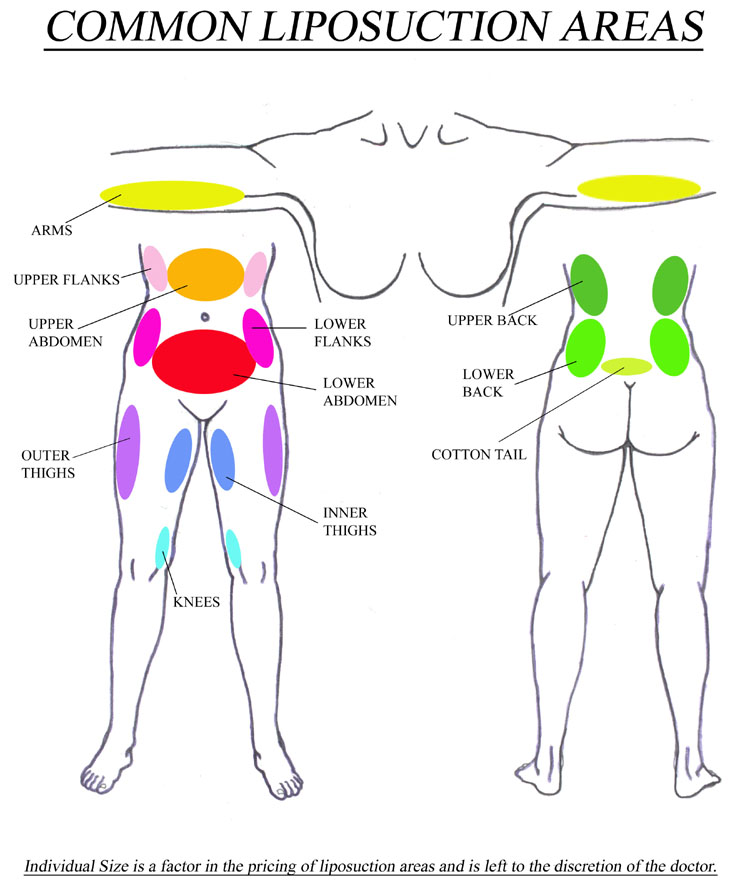Liposuction is a procedure recommended to a patient who desires an overall better contour or shape to his/her body. These areas of disproportion can be due to heredity rather than a lack of appropriate weight loss or fitness level. Often times liposuction is performed in conjunction with another procedure such as a tummy tuck.
The surgery involves using a thin cannula inserted into small incisions in strategic locations on the body to suction or remove the unwanted fat. A technique known as tumescent technique is most commonly performed. This allows the surgeon to infuse a saline solution with added anesthetic and epinephrine to aide in better removal of the fat. There is also a technique known as ultrasound assisted liposuction in which ultrasound energy is used to dissolve the fat prior to suctioning. The variation of the procedure will be discussed with each individual patient based on his/her needs.
Common areas of liposuction include: the chin, neck, upper arms, breast or chest, flanks, abdomen, hips, upper buttocks, inner and outer thighs, and medial knees.

It is important to note that liposuction is not a weight loss solution. It is best if the patient is in good shape and close to his/her ideal weight, but may have unwanted fatty deposits in certain areas not responding to diet or exercise. It is also not a corrective surgery for cellulite. In some cases, liposuction can visually make any dimpling in the skin worse.
Most surgeons require the use of a compression garment after surgery. This should be worn a minimum of four weeks or otherwise advised by your surgeon. The purpose of the garment is to reduce swelling as much as possible. It’s the last process in obtaining a good result after surgery. Most of the results will be seen in the first three months. However, a full year is sometimes needed to see the overall final result.
Frequently Asked Questions:
How much is the procedure?
The cost* varies depending on the number of areas liposuctioned, the time it takes to do so, and if radio-frequency plasma skin-tightening (Renuvion) is also an option. Visit Renuvion for more information.
*Cash discount pricing is available
Where can I find a post-operative garment?
You can search online at various stores for options. We do include the first post-operative garment. If you have questions on what type to purchase, please let us know and we can help.
What type of anesthesia is used?
General anesthesia is administered by a board certified anesthesiologist via an IV.
How long does the procedure last?
Surgery time varies depending on the number of areas liposuctioned.
What will it feel like when I wake up?
Most patients complain of general soreness in the areas done. It is common to feel some pressure and a bruising sensation in those areas as well.
When can I eat after surgery?
You will need to eat/drink something prior to taking your oral medications. As soon as you are ready to do so, you may.
I am draining through my garment, is this okay?
Yes, you will have drainage that consists of a clear, red fluid. This is normal and will subside over time. In the meantime, keep your garment on and wear inexpensive clothing.
When can I tan?
Tanning is not permitted for two weeks after surgery. After two weeks you may tan, but it is recommended to cover the scars for one full year from any exposure. Early exposure can cause the scars to become a dark color forever. Remember, it is best to keep the compression garment on as much as possible for the first four weeks.
When can I exercise?
No physical exertion is permitted for two weeks after surgery. Once you begin an exercise regimen, you must listen to your body. If it hurts or causes swelling, don’t do it. Swelling is not good. If you notice swelling after an activity, you must not continue with it.
When can I drive?
Driving is permitted as long as you are not under the influence of medications.

